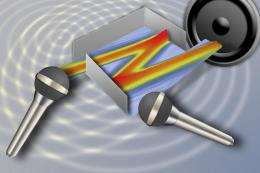Vienna physicists create tap-proof waves

Scientists at the Vienna University of Technology (TU Vienna) have developed a method to steer waves on precisely defined trajectories, without any loss. This way, sound waves could be sent directly to a target, avoiding possible eavesdroppers.
Tossing a ball to someone without anyone else being able to catch it is simple. Calling out to someone without anyone else hearing it is much harder. There seems to be a fundamental difference between waves and solid objects: a ball moves along a straight trajectory, whereas waves spread into all directions simultaneously. Quantum physicists at the Vienna University of Technology are proposing a new method to let waves travel on simple, straight trajectories. Applying this idea to acoustic waves, it would be possible to communicate with a person at the other side of a room without anyone else being able to hear anything. The findings were now published in the journal Physical Review Lettes.
The close connection between particles and waves is well known from quantum physics – and indeed, quantum physics was the starting point of this research project. “Initially, we were working on quantum effects in semiconductors. But our results can just as well be applied to acoustic or optical waves”, Professor Stefan Rotter explains. He developed the new method to control waves together with Florian Libisch and Philipp Ambichl. So far, the concept has only been tested in extensive computer simulations, but all the technology necessary to do experiments already exists. Professor Rotter is confident that the theories will soon be put to the test; “We have already contacted experimentalists, and we are hoping to see practical applications of our work soon.”
Rubber Balls are Tap-proof
Using the mathematical method developed at the TU Vienna, waves can be precisely tailored in such a way that they move along a designated line. Anyone who stays off this line will never be reached by the wave and can therefore never observe it. This way, a sound wave can be guided into a room, bounce off the walls like a rubber ball and leave the room again through the other door. This is not only useful to keep the wave away from eavesdroppers and microphones, it also helps to save energy. Eventually, all the wave’s energy is deposited exactly where it is supposed to, and not in regions where it cannot be used anyway.
Mathematical Concepts for Guiding Waves
Waves can spread in various ways, depending on the surroundings – this can be tested in concert halls. The shape and texture of the walls or play an important role, just like the roughness of the floor. “In the theoretical model, the behavior of the wave is described by a scattering matrix – a mathematical object that characterizes wave transport”, Florian Libisch explains. In the experiment, this scattering matrix has to be measured first – for instance by transmitting several reference signals prior to the actual message. The new wave guiding procedure then determines how the wave has to be tuned to keep it on the predetermined path.
The physicists from the TU Vienna are convinced that there is a broad range of possible applications. In addition to energy saving and tap-proof transmission of data, the method can also be used to concentrate waves at a particular region in space. “This could be useful in radiation therapy, where the energy of the wave should be dissipated in a tumor, and leave the surrounding tissue unaffected”, Florian Libisch says.
More information: Generating Particlelike Scattering States in Wave Transport Phys. Rev. Lett. 106, 120602 link.aps.org/doi/10.1103/PhysRevLett.106.120602
Provided by Vienna University of Technology


















